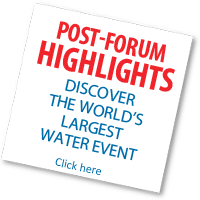


1.1 Guarantee access to water for all and the Right to water
| Back to list | Priority for Action 1.2 > |
| Priority for Action 1.1 “Guarantee access to water for all and the Right to Water” Coordinator: Swiss Agency for Development and Cooperation |
| Core group members Aquafed Coalition Eau Water and Sanitation Programme |
In 1990 77% of the world population used an “improved source” of water as defined by the WHO-UNICEF Joint Monitoring Program. End 2008 this percentage had been increased to 87% and the number of people without access to improved water sources had been reduced to around 900 million giving hope to reaching the MDG target on access to water by 2015.
However, progress is not evenly shared by all countries. Furthermore, billions of people need an access to water that is better than today. Not reflected in the above figures are people who are using water that is unsafe although it comes from improved water sources. Not reflected are also people who cannot use enough water because they face prohibitive costs or long walking and waiting times for collecting water, who receive water at occasional intervals, or who have to collect water from dangerous areas. Furthermore, in several areas, there is no progress but regress of conditions of life because the development of water services is outpaced by demographic growth. More ambitious plans are necessary in both rural and urban halves of the world (Targets 2 and 3).
In this context, the 2010 global recognition of the human right to safe drinking water confirms that more should be done to improve access to drinking water in the world. Indeed, this right guarantees all people access to sufficient quantities of safe, physically accessible, acceptable and affordable drinking water without discrimination. Although there is no global statistics available to number the people who do not benefit from this type of water, it is estimated that their number exceeds several billions. However, this absence of statistics makes it difficult to track progress with respect of these different characteristics of water used by people. Target 6 aims at identifying how appropriate statistics could be built.
The above water characteristics that are required by the human right to water are known by practitioners who are used to improve water safety, availability, affordability, etc. Though the recent recognition of the human right to water is an historical step for the water and human development sector, its implementation, built on practical experience, needs to be further developed. A key challenge of the 6th World Water Forum is to create the common understanding between the Human rights sector and the Water sector that is necessary for effective action. To stimulate this common understanding, Target 1 aims at gathering examples of effective public policies that specifically target one or several of the above characteristics in order to make the practical implications of the right to water visible and to create a practical linkage between the two sectors.
Out of the many bottlenecks that hinder progress towards a better access to water the preparatory process of the Priority for action 1.1 has selected two obstacles:
- the ignorance by decision-makers of water challenges in areas where there is no water services provided by a utility mandated by a government. Target 5 aims at organizing simple reporting mechanisms that allow identifying deficiencies and monitoring progress throughout a country.
- the need for local governments and water utilities and service providers to benefit from financial mechanisms that suit their needs and enable them to perform their tasks. These mechanisms can be based on loans, subventions or international aid and must suit the needs of local public, private and community based water operators.
| TARGET | TSG Coordinator(s) | Regional Links* |
| Target 1: For 2012, highlight the practical implications of the Right to Water for practitioners by collecting and disseminating at least one example per category in each region of national policies targeting and delivering effectively better water quality, availability, accessibility, affordability at country level, all major components of the human right to drinking water. | Water and Sanitation Programme | |
| Target 2: By 20xx, ensure that the global rural population without access to safe water decreases by x%, with special attention to the poor | Rural Water Supply Network | Americas Asia-Pacific Africa Europe |
| Target 3: By 20xx, ensure that the global urban population without access to safe water decreases by x%, with special attention to the poor. | UN Habitat International Water Association | Americas Asia-Pacific Africa Europe |
| Target 4: By 2015 more than half of countries in each continent have set up financial mechanisms that suit the needs of local authorities and local operators | International Secretariat for Water | |
| Target 5: By 2020 more than half of countries in each continent have organized a simple, inclusive and reliable reporting mechanism for water supply that includes every local water service providers in rural and urban areas. | French Development Agency | Americas |
| Target 6: By 2015, elaborate key global indicators regarding water quality, accessibility, availability, affordability and non-discrimination, all major components of the human right to drinking water. | WHO-UNICEF Joint Monitoring Programme |
| Back to list | Priority for Action 1.2 > |
Get involved and contribute!
Visit our Platform of Solutions to send your contribution to the relevant Target and Solutions Group.
* This column indicates when thematic and regional targets are matching and have a good potential for mutual contribution and partnership.






